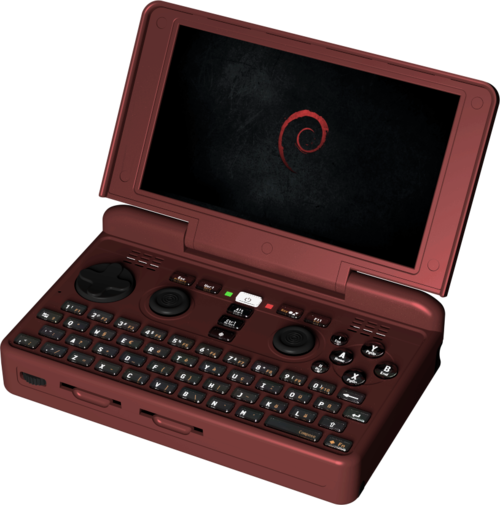Hardware overview: Difference between revisions
Jump to navigation
Jump to search
No edit summary |
No edit summary |
||
| Line 1: | Line 1: | ||
[[Image:Pyrared.png | right | 500px]] | [[Image:Pyrared.png | right | 500px]] | ||
The Pyra is a perfect pocket device for everyday computing, gaming, emulation or hacking. It is a unique combination of a gaming handheld and a mini-laptop (approximately the size of the Nintendo DS), running plain Debian Linux as OS. It is the successor of the [[OpenPandora]]. | The Pyra is a perfect pocket device for everyday computing, gaming, emulation or hacking. It is a unique combination of a gaming handheld and a mini-laptop (approximately the size of the Nintendo DS), running plain Debian Linux as OS. It is the successor of the [[OpenPandora]]. | ||
== Hardware == | == Hardware == | ||
=== Input Devices === | === Input Devices === | ||
* Gaming controls (DPad, 4 shoulder buttons, 6 face buttons) | |||
* Two accurate analog controls with push-button | |||
* QWERTY keyboard with backlight | |||
* Touchscreen | |||
* analog volume wheel | |||
=== Internals === | === Internals === | ||
* 6000mAh Battery | |||
* Integrated Wi-Fi 802.11a/b/g/n and Bluetooth 4.0 | |||
* Optional 3G/4G/UMTS and GPS | |||
* 720p 5" LCD (Interchangeable in the Future) | |||
* Vibration motor | |||
* Various sensors (accelerometer, gyro-sensor, etc.) | |||
* On an interchangeable CPU-Board: | |||
: | :* 2GB RAM | ||
: | :* Texas Instruments [[OMAP 5]] SoC: | ||
:: | ::* 2x ARM Cortex-A15 @ 1.5Ghz with NEON SIMD | ||
:: | ::* 2x ARM Cortex-M4 | ||
:: | ::* PowerVR™ SGX544-MP2 | ||
:: | ::* Vivante GC320 2D Accelerator | ||
=== Connectivity === | === Connectivity === | ||
* Headset-Port | |||
* 1x HDMI Video Out | |||
* Dual SDXC card slots | |||
* 1x MicroSDHC Slot | |||
* 2x Full-size USB Host (one can be used as eSATA-with a small adaptor) | |||
* 1x Micro USB 3.0 | |||
* 1x Micro USB (Debug and Charging) | |||
Revision as of 14:50, 26 December 2015

The Pyra is a perfect pocket device for everyday computing, gaming, emulation or hacking. It is a unique combination of a gaming handheld and a mini-laptop (approximately the size of the Nintendo DS), running plain Debian Linux as OS. It is the successor of the OpenPandora.
Hardware
Input Devices
- Gaming controls (DPad, 4 shoulder buttons, 6 face buttons)
- Two accurate analog controls with push-button
- QWERTY keyboard with backlight
- Touchscreen
- analog volume wheel
Internals
- 6000mAh Battery
- Integrated Wi-Fi 802.11a/b/g/n and Bluetooth 4.0
- Optional 3G/4G/UMTS and GPS
- 720p 5" LCD (Interchangeable in the Future)
- Vibration motor
- Various sensors (accelerometer, gyro-sensor, etc.)
- On an interchangeable CPU-Board:
- 2GB RAM
- Texas Instruments OMAP 5 SoC:
- 2x ARM Cortex-A15 @ 1.5Ghz with NEON SIMD
- 2x ARM Cortex-M4
- PowerVR™ SGX544-MP2
- Vivante GC320 2D Accelerator
Connectivity
- Headset-Port
- 1x HDMI Video Out
- Dual SDXC card slots
- 1x MicroSDHC Slot
- 2x Full-size USB Host (one can be used as eSATA-with a small adaptor)
- 1x Micro USB 3.0
- 1x Micro USB (Debug and Charging)